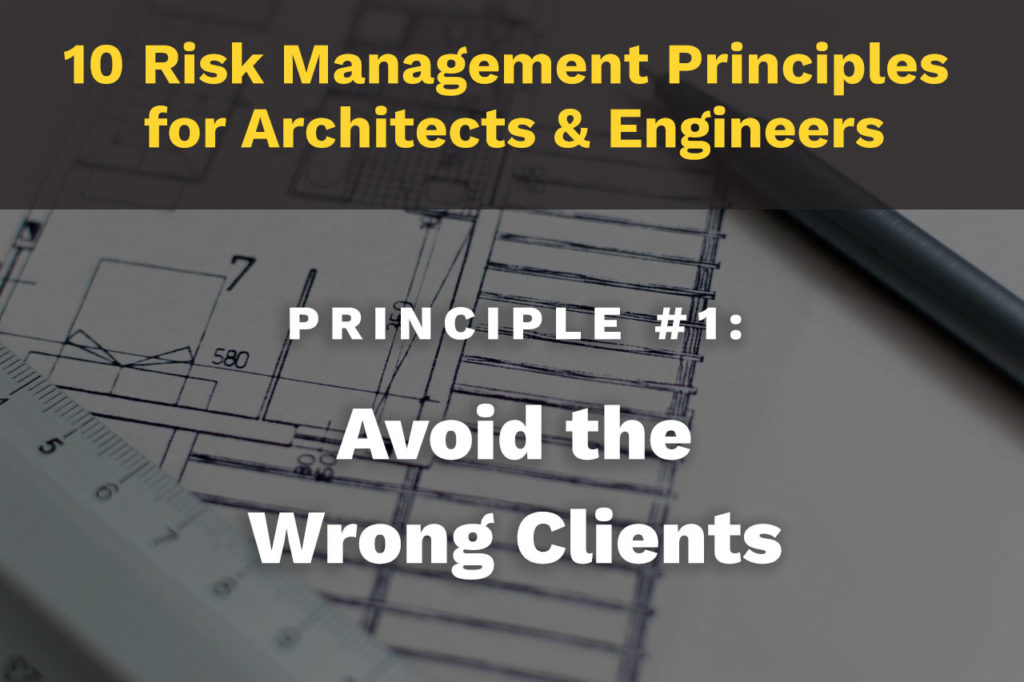For Design Professionals, there are many potential risks coming from many different sources. People often associate risk with being sued, but another major risk to consider is the risk of not getting paid.
One way to significantly mitigate both of these risks is to avoid working with the wrong clients.
Each client is different and has their own special needs. So do their projects. The wrong client with the wrong project can shift a Design Professional’s focus from doing top-notch work to simply getting the job done as fast as possible just to move on from the relationship.
In this article, you’ll learn how a Design Professional can strengthen their client selection process and loss prevention strategies by asking the right questions.
5 Questions that Strengthen the Client Selection Process
Avoiding the wrong client begins with being proactive during the client selection process. Be sure to document a list of essential criteria you want to use to qualify prospective clients. In order to develop your criteria, ask the following questions:
Question #1: Are you negotiating with the client or with a “hired gun?”
A “hired gun” is an individual seeking the best outcome for only the client and the project. The hired gun has no interest in what’s best for the working relationship between you and the client.
When not negotiating with the client directly, communication becomes more difficult. Questions are not answered in a timely manner, there can be unclear expectations and goals for the project, and overall a weaker Design Professional and client relationship. This could mean a less profitable project with potentially a struggle to get paid in a timely manner.
Question #2: Have you noticed any red flags?
In your early meetings with a client, listen to them for use of impactful or loaded statements and questions. These types of statements might include:
- We had to fire our last design firm.
- Our last project did not go well.
- You might need to increase your insurance limits.
- Will you begin work prior to signing the contract?
Follow up on these red flags and ask for deeper explanations if anything seems suspicious. Be on high alert for any past issues with cutting corners on the permit process, code compliance, or cost.
Question #3: How sophisticated is this client?
Whether the client is a single family homeowner, a corporation, or a school board, some clients just won’t be very knowledgeable about the design process. As we qualify a client and use our selection process, it’s important to understand where that potential client is coming from.
This will indicate how you approach the project, how you need to document, and the amount of education you’ll need to put forth throughout the process.
Question #4: For current clients, should you repeat?
It’s important to remember that you have the power to not continue forward with a difficult client on a subsequent project. A difficult client might be one that:
- Doesn’t pay invoices on time
- Consistently pushes for expanded scope
The client selection process applies to current clients, too. Re-evaluate a current client any time their contract is up for renewal or before beginning a new project with them.
It is important to also mention the benefits of working with repeat clients. You already understand their ways of working, their expectations, and their temperament. These kinds of insights are invaluable.
However, if these insights reveal that this client is bad for business or might increase your risk of profit loss, choosing to discontinue the relationship may be the best move.
Question #5: What is the contract negotiation process telling you?
Ask for the contract early in the process. Find out what type of contract is being offered and then assess the prospect’s willingness to negotiate terms.
If a client asks you to begin a project without a contract, that may potentially violate licensing requirements under the Business & Professions Code. Insist on creating a contract early in the process to protect your firm and create leverage with the client.
About Black Swan
Black Swan Risk Management was founded to keep Architects and Engineers up-to-date on Professional Liability Insurance in a Design World that is constantly changing.
Black Swan is your resource for industry-specific information on contract review and negotiation. Find templates, go/no-go checklists, certification resources, educational materials, consultative services, and more.
At Black Swan, our clients find actionable insurance solutions for complex design projects. We use flexible techniques and best-in-class communication, so that clients can fully understand their insurance and feel well taken care of. For you this means less stress and lower premiums.

